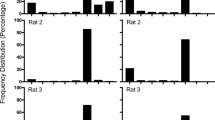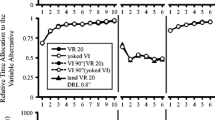Abstract
Using automatic recording and observational technique, nine behaviors of food-deprived rats were studied when lever pressing was reinforced with food pellets on a variable-interval schedule. The concurrent behaviors were activity around the lever, activity around the food cup, wheel running, exploration, standing up, face grooming, body grooming, and immobility. Compared with a baseline condition without food pellet delivery, time allocation increased for lever pressing, lever activity, and food-cup activity and decreased for exploration, standing, grooming, and immobility. Time allocation to wheel running increased for rats with a low level of baseline running and decreased for rats with a high baseline level. Time allocation to concurrent behaviors was heterogeneous for different lengths of interresponse times (Irts) in lever pressing. Lever activity dominated short Irts, food-cup activity, exploration, and standing dominated intermediate Irts, and wheel running and grooming dominated long Irts. Overall sequential analysis showed that transition probability to a given behavior depended upon the topography of the immediately prior behavior. More fine-grained kinematic analysis showed that transition probabilities were dependent upon their position within behavior sequences. The experiment illustrates how patterns of operant and concurrent behaviors are ordered at the moment-to-moment level rather than random.
Similar content being viewed by others
References
ANDERSON, M. C., & SHETTLEWORTH, S. J. (1977). Behavioral adaptation to fixed-interval and fixed-time food delivery in golden hamsters. Journal of the Experimental Analysis of Behavior, 25, 33–49.
BERNSTEIN, D. J., & EBBESEN, E. B. (1978). Reinforcement and substitution in humans: A multiple-response analysis. Journal of the Experimental Analysis of Behavior, 30, 243–253.
Delprato, D. J. (in press). Response patterns. In H. W. Reese & L. J. Parrott (Eds.), Advances in behavior science. New York: Lawrence Erlbaum Associates.
DUNHAM, P. J. (1972). Some effects of punishment upon unpunished responding. Journal of the Experimental Analysis of Behavior, 17, 443–450.
EPSTEIN, R. (1985). The spontaneous interconnections of three repertoires. The Psychological Record, 35, 131–141.
HANN, D. M., & ROBERTS, A. E. (1984). Free operant avoidance behavior in hooded rats: Irts and response chains. Animal teaming and Behavior, 12, 175–183.
HENTON, W. W. (1981a). Concurrent classical conditioning. The Psychological Record, 31, 1395–411.
HENTON, W. W. (1981b). Kupalov conditioning: Molecular control of response sequences. The Psychological Record, 31, 489–509.
HENTON, W. W. (1985). Interresponse times and the molecular control of behavior: Irts conditional upon changeovers to alternate behaviors. The Psychological Record, 35, 549–557.
HENTON, W. W., & IVERSEN, I. H. (1978). Classical conditioning and operant conditioning: A response pattern analysis. New York: Springer Verlag.
HERRNSTEIN, R. J. (1974). Formal properties of the matching law. Journal of die Experimental Analysis of Behavior, 21, 159–164.
HOLLAND, P. C. (1979). The effects of qualitative and quantitative variation in the Us on individual components of Pavlovian appetitive conditioned behavior in rats. Animal Learning and Behavior, 7, 424–432.
IVERSEN, I. H. (1976). Interactions between reinforced responses and collateral responses. The Psychological Record, 26, 399–413.
IVERSEN, I. H. (1981). Response interactions with signaled delay of reinforcement. Behavior Analysis Letters, 1, 3–9.
IVERSEN, I. H. (1982). Contiguity and response generalization. Behavior Analysis Letters, 2, 185.
IVERSEN, I. H. (1985a). Response interactions in multiple schedules: The influence of response displacement. The Psychological Record, 35, 401–410.
IVERSEN, I. H. (1985b). Restricted access to collateral behavior affects operant behavior on variable-interval schedules. The Psychological Record, 35, 411–424.
KANTOR, J. R. (1959). Interbehavioral psychology: A sample of scientific system construction. Chicago: Principia.
KEEHN, J. D., & NOBREGA J. (1978). Stereotyped behaviors during acquisition and extinction in rats. The Psychological Record, 28, 245–251.
KING, G. D. (1974). Wheel running in the rat induced by a fixed-time presentation of water. Animal teaming and Behavior, 2, 325–328.
KUO, Z. Y. (1967). The dynamics of behavior development: An epigenetic view. New York: Plenum Press.
LEVITSKY, D., & COLLIER, G. (1968). Schedule-induced wheel running. Physiology and Behavior, 3, 571–573.
LYON, D. O. (1982). Concurrent behavior: Are the interpretations mutually exclusive? The Behavior Analyst, 5, 175–187.
LYON, M., & ROBBINS, T. (1975). The action of central nervous system drugs: A general theory concerning amphetamine effects. In W. ESSMAN & L. VALZELLI (Eds.), Current developments in psychopharmacology (Vol. 2). New York: Spectrum.
LYONS, C. A., & CHENEY, C. D. (1984). Time allocation in a multiresponse environment: Effects of restricting response classes. Journal o f the Experimental Analysis of Behavior, 41, 279–289.
NEVIN, J. A., & BAUM, W. M. (1980). Feedback functions for variable-interval reinforcement. Journal of the Experimental Analysis of Behavior, 34, 207–217.
OSBORNE, B., & BLACK A. H. (1978). A detailed study of behavior during the transition from acquisition to extinction in rats with fornix lesions. Behavioral Biology, 23, 271–290.
PARKER, L. A. (1982). Nonconsummatory and consummatory behavioral Crs elicited by lithium-and amphetamine-paired flavors, teaming and Motivation, 13, 281–303.
PAVLOV, I. P. (1927). Conditioned reflexes (G. V. ANREP, Trans.). London: Oxford (reprinted New York: Dover, 1960).
PENNEY, J., & SCHULL, J. (1977). Functional differentiation of adjunctive drinking and wheel running in rats. Animal Learning and Behavior, 5, 272–280.
PREMACK, D. (1965). Reinforcement theory. In D. LEVINE (Ed.), Nebraska Symposium on Motivation. Lincoln: University of Nebraska Press.
RAY, R. D., & BROWN, D. A. (1975). A systems approach to behavior. The Psychological Record, 25, 459–478.
RAY, R. D., UPSON, J. D., & HENDERSON, B. J. (1977). A systems approach to behavior Iii: Organismic pace and complexity in time-space fields. The Psychological Record, 27, 649–682.
REID, R. L. (1957). The role of the reinforcer as a stimulus. British Journal of Psychology, 49, 202–209.
ROPER, T. J. (1978). Diversity and substitutability of adjunctive activities under fixed-interval schedules of food reinforcement. Journal of the Experimental Analysis of Behavior, 30, 83–96.
SCHOENFELD, W. N. (1971). Conditioning the whole organism. Conditional Reflex, 6, 125–128.
SEGAL, E. F. (1972). Induction and the provenance of operants. In R. M. GILBERT & J. R. MILLENSON (Eds.), Reinforcement: Behavioral analysis. New York: Academic Press.
SHIMP, C. P. (1969). Optimal behavior in free-operant experiments. Psychological Review, 76, 97–112.
SILBERBERG, A., HAMILTON, B., ZIRIAX, J. M., & CASEY, J. (1978). The structure of choice. Journal of Experimental Psychology: Animal Behavior Processes, 4, 368–398.
SKINNER, B. F. (1938). The behavior of organisms. New York: Appleton-Century-Crofts.
SMITH, J. B., & CLARK, J. B. (1974). Intercurrent and reinforced behavior under multiple spaced-responding schedules. Journal of the Experimental Analysis of Behavior, 21, 445–454.
STADDON, J. E. R. (1977). Schedule-induced behavior. In W. K. HONIG & J. E. R. STADDON (Eds.), Handbook of operant behavior. Englewood Cliffs, NJ: Prentice-Hall.
STADDON, J. E. R., & AYRES, S. L. (1975). Sequential and temporal properties of behavior induced by a schedule of periodic food delivery. Behaviour, 54, 26–49.
WETHERINGTON, C. L., BROWNSTEIN, A. J., & SHULL, R. L. (1977). Schedule-induced running and chamber size. The Psychological Record, 27, 703–713.
WONG, P. T. (1977). A behavioral field approach to instrumental learning in the rat I. Partial reinforcement effects and sex differences. Animal Learning and Behavior, 5, 5–13.
Author information
Authors and Affiliations
Additional information
Preparation of the manuscript was supported by a grant from the Danish Research Council of the Humanities and by a research fellowship from the University of Copenhagen.
Rights and permissions
About this article
Cite this article
Iversen, I.H. Time Allocation, Sequential, and Kinematic Analyses of Behaviors Controlled by An Aperiodic Reinforcement Schedule. Psychol Rec 36, 239–255 (1986). https://doi.org/10.1007/BF03394944
Published:
Issue Date:
DOI: https://doi.org/10.1007/BF03394944




